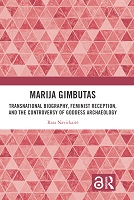Chapter 4 New Archaeology, Old Europe, and the Feminist Science Debates
Proposal review
Marija Gimbutas’ “Pre-Her-Story” in Academia
Abstract
The chapter traces Gimbutas’ engagement with gender as a research topic, proposing that her work on European prehistory should be seen as written from a feminist point of view. It explains her contributions to rewriting prehistory from a women-centered perspective, her reinterpretations of female symbolism in early figurative art, and her implicit critique of the androcentric narratives of the development of Western civilization. It discusses also Gimbutas’ scholarly persona and the way she combined aspects of an Enlightenment ideal of disinterested perspective with a Romantic notion of scholarly discovery as divine inspiration, which she expressed through reference to the Lithuanian folk figure of a witch – the Ragana. The chapter analyzes the critiques of Gimbutas’ work and places them within the context of the changing paradigms of the discipline of archaeology. It shows how the introduction of post-structuralist feminist approaches to archaeology changed the way scholars perceive the question of gender in prehistory and, by extension, Gimbutas’ work. The chapter proposes to consider her work as a “pre-her-story” of archaeology.


 Download
Download